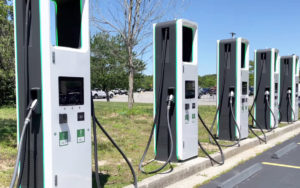Updated projections for Canada’s public EV charging infrastructure, in a new report prepared by Dunsky Energy and Climate Advisors for Natural Resources Canada, offer a blueprint for future charging needs and federal deployment policy

By 2030, the federal government expects to see 4.6 million electric vehicles on Canadian roads. To meet those vehicles’ charging needs, it says the country will have to install approximately 200,000 publicly accessible chargers by that date.
Updated projections for Canada’s public EV charging infrastructure, in a new report prepared by Dunsky Energy and Climate Advisors for Natural Resources Canada, offer a blueprint for future charging needs and federal deployment policy
By 2030, the federal government expects to see 4.6 million electric vehicles on Canadian roads. To meet those vehicles’ charging needs, it says the country will have to install approximately 200,000 publicly accessible chargers by that date — a mix of Level 2 and DC fast chargers that works out to a ratio of one charger for every 24 electric vehicles.
That’s just one of a number of critical, top-line findings in a new report, “Canada’s Public Charging Infrastructure Needs,” prepared by Dunsky Energy and Climate Advisors and released last week by Natural Resources Canada.

Photo: Jonathan Wilkinson/LinkedIn
The study is a much-anticipated follow-up to a similar report done by Dunsky for the government in 2018. It takes into account recent market trends and bases its projections on the expectation that zero-emission vehicles will make up 15 per cent of light-duty vehicle sales in Canada in 2025, 60 per cent of sales by 2030 and 100 per cent of sales by 2035.
“The independent findings in this report are consistent with Canada’s targets for charging infrastructure — we are on the right track,” said Jonathan Wilkinson, Minister of Natural Resources, in a detailed press release accompanying the report.
Home charging a key factor
The report offers detailed projections for the number of different types of chargers that will be needed at five-year intervals all the way out to 2050. Of note, it also calculates those figures according to two scenarios — one in which Canadian enjoy high access to home charging and the other in which there is lower access.
“Charging at home overnight is the most convenient option for EV owners and can also be the most cost-effective option when charging infrastructure is deployed at scale and incorporated into new buildings during construction,” the report states.
The study’s analysis also focuses on two primary use cases: highway corridor charging (DC fast chargers exclusively) and community cluster charging (DC fast and Level 2 combined).

When it comes to DC fast chargers, in particular, the report identifies a need for 4,300 DC fast charger ports as early as 2025, up from an installed based of approximately 3,000 DC fast charger ports in November 2021. That figure grows to 13,800 by 2030 in the high access to home charging scenario, and 14,100 in the lower home access scenario.
For those wondering about the associated costs, the report estimates that adequate deployment of charging infrastructure will require a $20-billion investment between now and 2050. However, it doesn’t assess what portion of this might come from the federal government, the role of provincial and municipal governments or the private sector.
Private sector investment
It’s clear from statements in the NRCan release, that the government expects increasing private sector investment as the EV market matures.
“As we continue to make EVs more accessible and affordable for Canadians, the business case for private investment in publicly available charging infrastructure is becoming more apparent, and I look forward to seeing even more industry players installing chargers across the country,” said Wilkinson.






